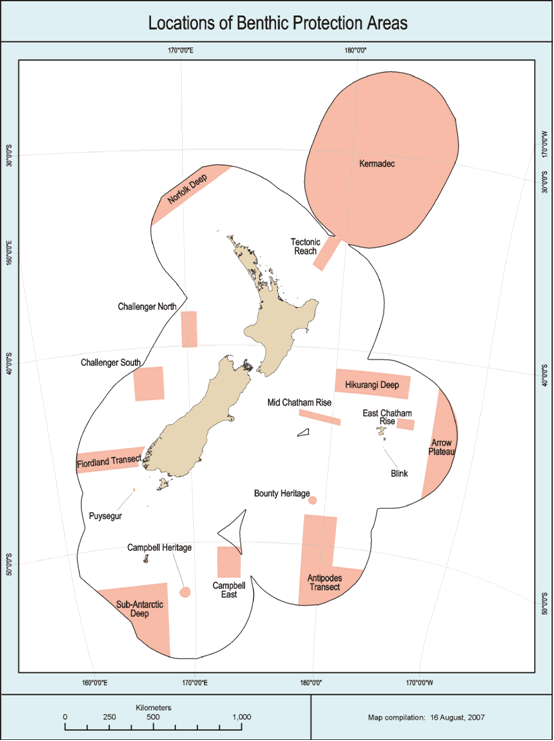Reducing impacts on benthic habitats and the wider environment
One approach to managing fishing impacts on the seabed is through the use of spatial controls. A wide variety of controls apply in New Zealand waters. Some of these were introduced specifically to manage the impacts of fishing on the seabed (see map below). Other closures exist for other reasons, such as for protecting cables, but have the effect of protecting certain areas of seabed from disturbance. These are discussed further in the Marine section.
Within the EEZ, 17 areas around underwater features (including some surrounding seamounts) and 17 Benthic Protection Areas have been closed to trawling to protect benthic habitats, as shown in the map below. Other forms of fishing are allowed in these areas.

Other approaches to reducing the impacts of trawling on benthic habitats include:
- Ensuring that trawl equipment does not come into contact with the sea floor
- Avoiding trawling in areas which have not already been impacted
- Minimising the size of the trawl footprint
- Increasing the time period between repeated trawling of the same area to enable recovery
- Excluding trawling activity from vulnerable marine ecosystems (see box below) and areas of ecological benthic importance such as coral and sponge gardens, shellfish beds, seagrass beds, hard and shelly substrates, seamounts and underwater features
- Adopting new trawl technology which reduces contact with the seafloor
The Food and Agriculture Organization’s 2009 international guidelines on deep sea fishing provide criteria to assist with identifying vulnerable marine ecosystems which are recommended to be specifically protected from the impacts of fishing. These guidelines are not binding and are focused on implementing the United Nations General Assembly resolution on sustainable fisheries (UNGA61/105). The criteria provided by the guidelines include: 1928
a) Uniqueness or rarity – an area or ecosystem that is unique or that contains rare species whose loss could not be compensated for by similar areas or ecosystems. These include:
- habitats that contain endemic species;
- habitats of rare, threatened or endangered species that occur only in discrete areas; or
- nurseries or discrete feeding, breeding, or spawning areas.
b) Functional significance of the habitat – discrete areas or habitats that are necessary for the survival, function, spawning/reproduction or recovery of fish stocks, particular life history stages (e.g. nursery grounds or rearing areas), or of rare, threatened or endangered marine species.
c) Fragility – an ecosystem that is highly susceptible to degradation by anthropogenic activities.
d) Life-history traits of component species that make recovery difficult – ecosystems that are characterised by populations or assemblages of species with one or more of the following characteristics:
- slow growth rates;
- late age of maturity;
- low or unpredictable recruitment; or
- long-lived.
e) Structural complexity – an ecosystem that is characterized by complex physical structures created by significant concentrations of biotic and abiotic features. In these ecosystems, ecological processes are usually highly dependent on these structured systems. Further, such ecosystems often have high diversity, which is dependent on the structuring organisms.
-
Food and Agriculture Organization of the United Nations, 2009
Last updated at 4:09PM on November 23, 2017